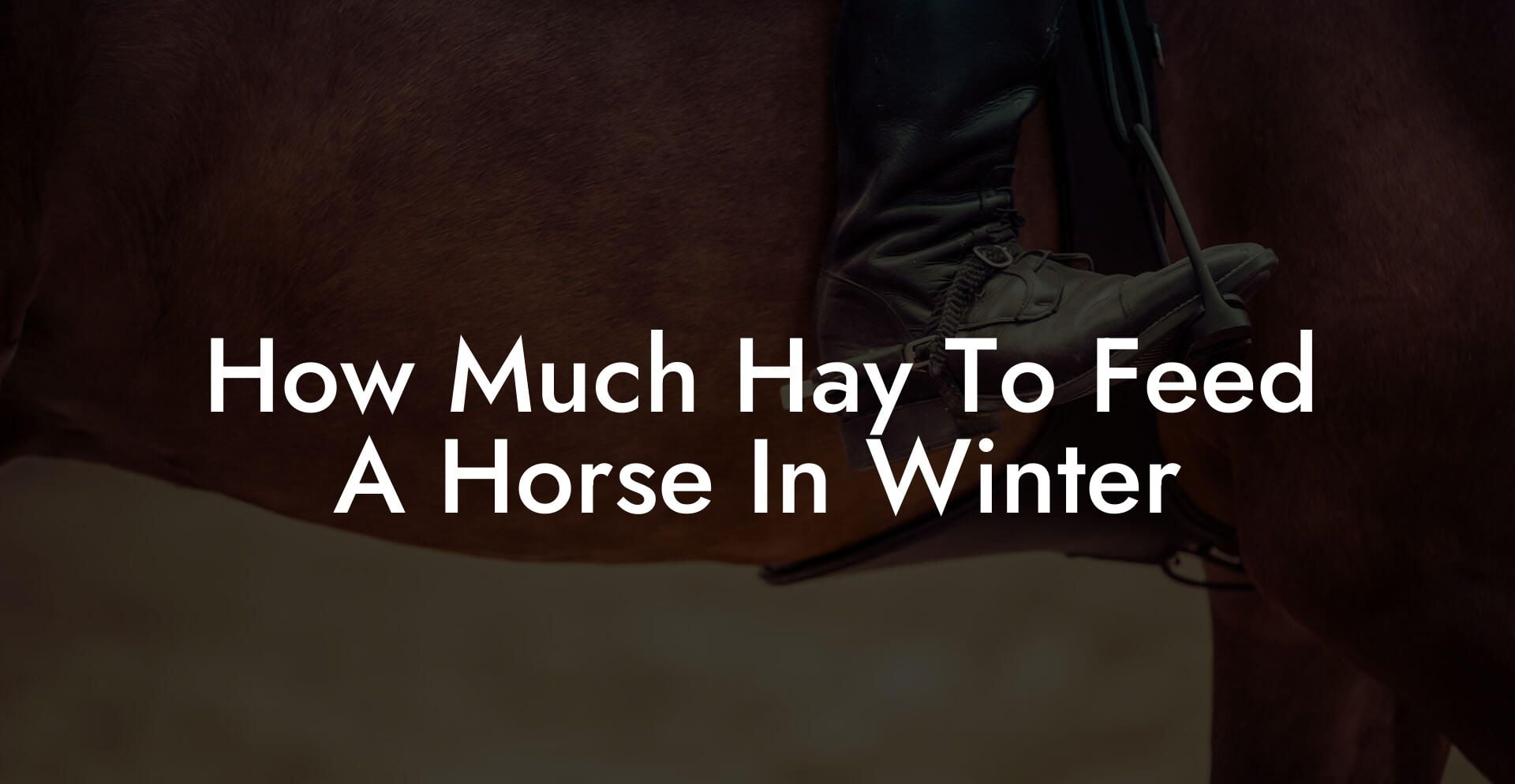Winter can feel like a never-ending series of frosty adventures for both horses and their human besties. Picture your equine friend, bundled up and ready to face the chill, munching on hay as if it were the latest avocado toast trend. But how much hay do they actually need to keep their energy high and their coats shiny during the cold months? Buckle up and get ready for a deep dive into the world of winter hay feeding, a topic that’s as much about science as it is about a genuine love for our majestic four-legged pals.
Quick Links to Useful Sections
- Understanding Your Horse's Nutritional Needs in Winter
- The Science Behind Winter Hay Feeding: What's in Your Hay?
- How Environment Affects Hay Intake: Weather, Shelter, and More
- How Much Hay Should You Feed? Insider Tips from the Experts
- Choosing the Right Hay: Grass vs. Alfalfa, and More
- Common Pitfalls in Winter Horse Feeding (and How to Avoid Them)
- Tailoring Your Horse's Diet: Customizing Feeding Based on Age, Activity, and Health
- Integrative Approaches to Horse Feeding: Balancing Hay, Concentrates, and Supplements
- Resources and Community Support: Your Next Steps
- Frequently Asked Questions: How Much Hay To Feed A Horse In Winter
- Your Journey to Equine Winter Wellness
Understanding Your Horse's Nutritional Needs in Winter
Just like us, horses face a number of challenges during the winter months. Shorter days, dropping temperatures, and the extra calories required to keep warm mean that their dietary needs change when Jack Frost pays a visit. The first step in managing winter feeding is understanding that horses are naturally grazing animals whose digestive systems have evolved to handle a steady, fiber-rich diet. In winter, although fresh pasture might be scarce, hay becomes the reliable, go-to fuel.
During winter, a horse’s metabolism ramps up, usually requiring an increase in caloric intake to maintain body heat. Hay acts as a slow-burning source of energy that helps distribute heat over a long timeframe. The right balance of hay can stave off the risk of weight loss, improve digestion, and support overall health. After all, no one wants a chilly horse with a chilly attitude!
For a modern horse caretaker, especially if you find yourself scrolling through TikTok or Instagram for the latest equine trends, the winter hay dilemma is a perfect blend of tradition and innovation. With the right approach, you ensure your horse gets optimum nutrition with the sprinkle of a few modern management tips that resonate with our fast-paced, data-driven lifestyles.
The Science Behind Winter Hay Feeding: What's in Your Hay?
At its core, hay is the dried version of grass, and while it may look simple, its nutritional complexity is anything but. The quality of hay plays a starring role in your horse's winter diet. High-quality hay should be free from mold, dust, and excessive weeds, ensuring that your horse gets a nutrient-dense meal.
Here are the key nutritional elements you need to consider:
- Fiber: Crucial for healthy digestion, fiber provides the bulk and promotes proper gut motility. Horses have sensitive digestive systems that thrive when fed consistent, fibrous meals.
- Energy (Calories): The roughage in hay is a slow-release source of energy. In winter, horses require extra calories to help maintain their core temperature.
- Protein: While hay isn’t the richest source of protein, it does contribute to muscle maintenance and repair. However, don’t rely solely on hay for high-protein needs, especially for young or athletic horses.
- Moisture: The moisture content in hay can affect its energy density. Fresh-fallen hay tends to have some moisture, but overly damp hay can spoil quickly. Dry, well-cured hay is optimal for winter months.
Modern equine nutritionists often use laboratory tests to analyze hay samples for nutrient content. Understanding the balance of these nutrients isn’t just academic, it translates to practical feeding strategies that will help you adjust amounts and types of hay based on your horse's needs.
And remember, with our busy, always-online lifestyles, tapping into apps and online calculators can help simplify this process. Input a few parameters, like your horse’s weight, age, and activity level, and get a tailored recommendation that takes the guesswork out of winter feeding.
How Environment Affects Hay Intake: Weather, Shelter, and More
Mother Nature isn’t just a background character in our feeding saga, she plays a leading role. When temperatures drop, horses actually burn more calories simply to keep warm. Even if your horse is stabled, cold air around the stable door can cause heat loss, driving a need for more calorie-dense nutrition.
Additionally, the environment plays a key role in how efficiently a horse digests its hay. For instance, if your horse is sheltered from biting winds and wet conditions, it will have a lower energy requirement compared to a horse that is constantly battling winter elements outside. Hence, the availability of proper shelter and windbreaks is essential not only for comfort but also for effective nutritional management.
The amount of hay your horse will consume can also be influenced by its daily exercise routines and overall activity level during winter. A horse that gets plenty of movement, even in the cold, will digest and metabolize hay differently compared to one that’s just lounging around in a stall.
So, when adjusting your winter feeding plan, consider these environmental factors: is your horse in a heated stall, or is it braving the elements? Is there plenty of wind protection, or do you need to invest in some additional sheltering? Tailoring your hay feeding strategy based on these factors will definitely keep your horse both toasty and healthy.
How Much Hay Should You Feed? Insider Tips from the Experts
Here’s where the burning question takes center stage: How much hay do you actually need to feed your horse during winter? While there’s no one-size-fits-all answer, several expert guidelines can help you nail down a plan that suits your horse’s unique needs.
The general consensus among equine nutritionists is that adult horses should consume roughly 1.5% to 2.5% of their body weight in hay daily. For example, if you have a 1,000-pound horse, that translates to 15 to 25 pounds of hay per day. This range can shift depending on several variables:
- Activity Level: More active horses may require more hay to fuel their energy levels.
- Age and Condition: Growing horses, seniors, or those with health issues might have specialized needs.
- Type of Hay: Denser, more calorie-rich hays will result in lower volume requirements, while lower quality or lower calorie hay may require feeding in larger amounts.
It’s important to keep in mind that these guidelines serve as a starting point. Regular monitoring of your horse’s body condition, weight fluctuations, and behavior will alert you if adjustments are necessary. And if you’re ever in doubt, a chat with your equine nutritionist or vet can provide you with tailored advice.
For the data-savvy equine enthusiast, keeping records via digital trackers and feeding logs can make a world of difference. By logging daily hay intake and performance metrics, you can sort out trends and quickly pinpoint if your horse’s needs are shifting over the winter months.
Choosing the Right Hay: Grass vs. Alfalfa, and More
Not all hay is created equal. If you’re wondering whether your horse should be guzzling grass hay, alfalfa hay, or a mix of both, it’s time to flirt with some science. Grass hay, which is lower in calories and protein, is perfect for mature horses with moderate activity. In contrast, alfalfa hay is denser in energy and protein, making it a viable option for horses who need extra nutrients, though it can be a bit rich for those prone to weight gain.
Many modern horse owners opt for a blend of both types to create a balanced diet, ensuring that their horses receive the necessary energy without tipping into excessive calorie intake. The decision may also depend on what’s locally available, sometimes the best hay is simply the one your local supplier sources the best quality.
Additionally, some horses might have dietary sensitivities that make one type more suitable than the other. For instance, horses with metabolic conditions might do better on grass hay, while those needing muscle repair may benefit from the higher protein content of alfalfa. Always be on the lookout for signs like weight fluctuations, changes in coat quality, or digestive issues, and adjust the type and amount of hay accordingly.
Remember, hay is just one part of the winter diet puzzle. In some cases, you might supplement with concentrates or feeds carefully designed for the winter months. However, forage should always be the foundation of your horse’s diet, not only because it promotes healthy digestion but also because it mimics their natural grazing habits.
Common Pitfalls in Winter Horse Feeding (and How to Avoid Them)
Even the most dedicated horse enthusiasts can fall prey to common feeding mistakes during winter. Awareness is your best defense against these pitfalls, ensuring your horse stays healthy and happy all season long.
Overfeeding or Underfeeding: Striking the right balance is key. Overfeeding can lead to obesity and related health issues, while underfeeding can sap your horse’s energy and compromise its immune system. Using the recommended guidelines (1.5% to 2.5% of body weight) as a starting point is great, just be sure to adjust based on your horse’s body condition and energy levels.
Poor Quality Hay: Low-grade hay that’s dusty, moldy, or contaminated with weeds can lead to respiratory issues or digestive upset. Always source hay from reliable suppliers, and if possible, invest in hay analysis tests to ensure you’re getting the right nutritional profile.
Neglecting the Horse’s Overall Diet: While hay is critical, your horse might also need additional supplements, salt, or even concentrated feeds during the winter months. Ignoring these extra components could result in imbalances that affect overall health.
Ignoring Environmental Factors: As we’ve discussed, horses in a well-sheltered environment have different requirements than those braving the elements. Failing to account for local weather and stable conditions can throw off your feeding plan.
Lack of Monitoring: Rather than setting your feeding schedule on auto-pilot, actively monitor your horse’s body condition score (BCS), behavior, and overall vitality. Small adjustments can lead to big differences in overall wellness.
To avoid these pitfalls, keep a detailed feeding log, consult with your veterinarian, and remain open to tweaking your strategy as conditions change. After all, treating your horse’s health like a science experiment often means being willing to adjust hypotheses as more data rolls in.
Tailoring Your Horse's Diet: Customizing Feeding Based on Age, Activity, and Health
Just as no two horses are exactly alike, a one-size-fits-all feeding strategy rarely works when it comes to equine nutrition. Horses vary by age, activity level, and overall health, making it essential to customize your winter feeding plan.
Young Horses: Growing horses need extra protein and energy to support development. However, too much concentrated feed can be harmful. Balancing high-quality hay with controlled portions of supplemental feeds is a winning formula in this scenario.
Performance Horses: Horses involved in regular training or competition expend a lot of energy, which means their caloric needs spike even more during the winter months. A mix of nutrient-dense hay, concentrates, and added vitamins might be in order, but careful monitoring is required to avoid overfeeding.
Seniors and Horses with Health Issues: Older horses or those with metabolic disorders, dental issues, or digestive sensitivities demand a gentler, easily digestible diet that still meets their energy requirements. In these situations, softer, chopped hay or soaked hay cubes can be easier on sensitive mouths and stomachs.
The trick is to observe your horse’s condition and adjust feeding portions gradually. Health changes, weight fluctuations, or even subtle behavior shifts should prompt a review of your feeding plan. Use technology where you can, a smartphone app that tracks your horse’s weight and feed intake can serve as your winter watchdog to ensure everything stays on track.
Integrative Approaches to Horse Feeding: Balancing Hay, Concentrates, and Supplements
Modern equine nutrition isn’t just about dumping hay into a stall and calling it a day. Today’s horse caretakers are embracing integrative approaches that blend traditional feeding with cutting-edge nutritional insights. The idea? To create a balanced dietary plan that combines the best of hay, high-quality concentrates, and well-chosen supplements.
Hay as the Cornerstone: Remember, forage always comes first. High-quality hay should form the foundation of your horse’s winter diet. Not only does it promote natural grazing behavior, but its fiber content is critical for rumen health.
Supplemental Feeds and Concentrates: For horses with higher energy requirements or those in intense training, supplemental feeds can bridge the nutritional gap. Concentrates are formulated to provide additional calories and proteins, but they should never replace hay entirely.
Vitamins and Minerals: Winter can deplete essential vitamins and minerals. Electrolytes, biotin, and Omega-3 fatty acids are often added to help keep joints healthy, improve coat condition, and support overall immunity.
Herbal Supplements and Probiotics: Some forward-thinking horse owners are also experimenting with herbal solutions and probiotics to promote gut health. Although these natural approaches should complement, not replace, a balanced diet, they can help fine-tune your horse’s nutritional regimen.
Mixing and matching these components creates a dynamic dietary ecosystem that supports your horse’s physical performance, maintains a healthy gut flora, and even helps with immune system regulation during the stressful winter months.
Feel free to experiment under the guidance of an equine nutritionist. In today’s social media-savvy world, even hashtags like #HorseFuel and #WinterFeedingTips are proof that integrating holistic nutritional strategies is not only effective but totally on-trend.
Resources and Community Support: Your Next Steps
As you navigate the sometimes frosty realm of winter horse feeding, remember that you’re not alone. The vibrant online equine community is just a click away, with forums, social media groups, and virtual consults ready to help you master the art of hay management.
Here are a few resources and community support options to consider:
- Online Equine Forums: Websites like TheHorse.com and Chronicle of the Horse provide a wealth of articles, forums, and Q&A sections where experienced horse owners share their winter feeding strategies.
- Social Media Groups: Join Facebook groups or Instagram communities dedicated to horse care and feeding. These vibrant groups offer a platform for sharing tips, asking questions, and learning firsthand experiences from fellow enthusiasts.
- Local Equine Nutritionists and Veterinarians: Sometimes the best advice comes from experts in person. Schedule a consultation with a trusted equine nutritionist to review your winter feeding plan and make adjustments tailored to your horse’s unique needs.
- Mobile Apps and Digital Tools: Leverage technology by using apps designed to track your horse’s weight, performance, and feed intake. Tools like Equine Metrics can help you keep an eye on changes over the winter months and alert you if adjustments are needed.
- Workshops and Webinars: Keep an eye out for webinars and local events focusing on equine nutrition and winter care. These sessions provide up-to-date information on the latest research and trends in horse feeding.
Connecting with a community not only offers practical advice but also the emotional support that comes from knowing others are facing similar challenges. So, don’t be shy, dive into these resources, ask questions, and share your own journey. Your next steps could involve scheduling a vet visit, joining a new online discussion group, or simply updating your feeding log with the latest insights.
Frequently Asked Questions: How Much Hay To Feed A Horse In Winter
Navigating the winter feeding maze can spark a bunch of questions. Here are some of the most frequently asked questions about winter hay feeding along with answers that blend expert advice and contemporary insights:
1. How much hay should an average horse eat in the winter?
Generally, an adult horse should consume between 1.5% and 2.5% of its body weight in hay daily. For a 1,000-pound horse, that means about 15 to 25 pounds of hay each day, with adjustments based on activity level and environmental factors.
2. Should I change the type of hay in winter?
The decision to choose grass hay, alfalfa, or a blend depends on your horse’s individual needs. Grass hay is typically lower in calories, making it ideal for horses prone to weight gain, while alfalfa is rich in protein and energy, great for young or highly active horses.
3. How do environmental factors affect hay consumption?
Cold temperatures, wind, and lack of shelter can cause horses to burn more calories. This typically increases their hay requirements to help maintain body heat and energy levels.
4. Can supplements replace part of the hay in a winter diet?
Supplements can complement the hay, but they should never replace it. Hay is central to a horse’s digestive health, while supplements (such as vitamins, minerals, or probiotics) support overall wellness.
5. How do I know if my horse is getting too much or too little hay?
Regularly monitor your horse's body condition score, weight, and behavior. Sudden changes can indicate that adjustments in hay intake may be necessary. Consulting with your vet or equine nutritionist can also help tailor the perfect feeding plan.
6. What common mistakes should I avoid when feeding hay in winter?
Avoid overfeeding, underfeeding, and using poor-quality hay. Always monitor your horse’s condition, use reliable hay sources, and adjust for weather-related metabolic changes.
7. Is there any benefit to mixing concentrates with hay during winter?
Yes, in some cases, mixing heavy-duty concentrates can provide extra calories and nutrients needed for high-performance or young horses. However, this must be balanced carefully with the bulk of the diet provided by hay.
8. How can technology help me manage winter feeding?
Digital tools and mobile apps can help track your horse’s weight, record feeding logs, and adjust your feeding plan based on real-time data. This tech-forward approach is especially appealing to Gen-Z and millennial horse enthusiasts.
9. When should I consult a veterinarian or equine nutritionist?
If you notice any significant changes in your horse’s weight, coat condition, or behavior, it’s time to seek professional advice. Regular check-ups are key to ensuring your winter feeding strategy is on point.
10. How often should I adjust my horse’s feeding plan during the winter?
Seasonal changes and your horse’s individual needs may require periodic adjustments. It’s a good practice to review and tweak the feeding plan every few weeks or whenever noticeable changes occur.
Your Journey to Equine Winter Wellness
Embracing winter feeding is about more than just tossing hay into a stall; it’s a commitment to ensuring that your horse remains vibrant and energetic, despite the harsh winter weather. When you blend scientific insights with real-world practicality, you’re not just feeding a horse, you’re nurturing a friend who has been by your side through thick and thin.
By using the guidelines provided and keeping track of your horse’s changing needs, you empower yourself with the tools to adapt and thrive no matter how low the temperature dips. Whether you’re a millennial who loves staying on top of the latest tech-infused trends in equine care or a Gen-Z enthusiast bringing fresh ideas into the field, the principles of equine nutrition remain timeless.
Remember, every morsel of hay, every minute spent monitoring your horse’s health, and every conversation with fellow enthusiasts contributes to a culture of informed, compassionate horse care. Let this guide be your starting point, a blueprint that you can adjust and personalize as you develop your own unique equine wellness journey.
The winter months may be cold and challenging, but with careful planning, community support, and a bit of ingenuity, your horse can enjoy hearty meals that fuel snowy adventures and peaceful nights. Whether your journey includes experimenting with the latest equine nutrition apps or simply sharing a laugh with a fellow horse lover, know that every effort builds toward a healthier, happier stall-side experience.
Now is the time to put these insights to work and revolutionize your winter feeding routine. Embrace the process, trust your instincts, and celebrate every win, big or small. Your horse’s well-being is the sweetest reward, and with the perfect balance of hay, supplements, and community support, you’re well on your way to mastering the art of winter equine care.













